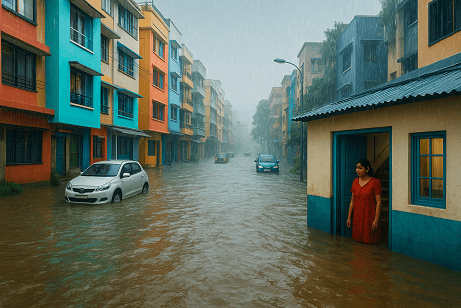Why 2025 witnessed the heaviest rainfall in decades? Geographical and Social reasons associated with it.

5 September 2025 | 11:41 am
Highlights
- Normal frequency of Western disturbances in India is usually 0 or 1 per month in July and August, maybe up to 2 in June. But this time there have seen 15th for the entire monsoon season of 2025.
- More WDs are starting to arrive during the monsoon and therefore Southwest Monsoons and western disturbances together brought heavy rainfall especially in Northern Parts of the India.
- Wetland degradation in India is a critical environmental crisis, with nearly two out of five wetlands disappearing in the last three decades .
- The pace of urban expansion has far exceeded the quality of supporting infrastructure, particularly in water drainage systems as many of these water bodies encroached upon.
- Government has strengthen Mission Mausam to detect the activities of Monsoons.
- General public do have the responsibility to not throw garbage in the water bodies and follow the guidelines for waste segregation.

Geographical Reasons - The strategic location of India on Map.
India is experiencing more western disturbances in monsoon than usual contributing to extreme rainfall, flash floods and landslides in the Western Himalayan region.
What is South West Monsoon?
The winds from south West Indian subcontinent is responsible for Monsoon in India , It begins in June and lasts till September and is a major seasonal wind system that brings substantial rainfall to the Indian subcontinent. These winds brings monsoon and hence these are called South West Monsoon
These winds brings moisture from the Indian Ocean and is characterized by heavy rains hence it is crucial for agriculture and water resources in India.
What are western disturbances?
Western disturbances are storms that originate in the Caspian or Mediterranean Sea, and bring non-monsoonal rainfall to northwest.
These western disturbance (extra tropical cyclonic circulations) may be forming closer to India this time when it comes to India it bring strong rains during monsoon and non-monsoon regions.
Why Monsoon arrive early in India this year?
Under normal conditions, the monsoon winds crosses central Kerala and reaches Karnataka around June 5th , but this year the monsoon winds arrive 10 days prior to its normal timeline due to the conditions which fulfil the onset of monsoons.
What Factors contributed to the early onset of Monsoons?
- When High pressure develops at the Indian ocean region and low pressure develops on the land, then wind flows from High pressure to low pressure and in this case monsoons winds carring moisture flows from ocean to land causing rainfall.
- This high pressure area develops at Mascarene Islands (located at South Indian ocean) and its called Mascarene High.
- This Mascarene High is a key factor in determining the intensity of monsoon. This year a stronger Mascarene High has developed and therefore a strong monsoon winds had travelled.
- A delay in the formation of Mascarene High means delay in monsoons in India.
Where is the low pressure developing in India?
Convection: It is a major factor for developing low pressure area around Haryana region. An increase in the convection activity which takes heat and moisture vertically and develops low pressure area. Hence Convection plays an important role in bringing the monsoon in India.
Somali Jet: It is an important factor associated with the strength of the monsoon in India, Strong somali jet means strong monsoons in India.
All these factors were usually led to the formation and onset of monsoons in India but a formation of strong Western disturbances near to Indian Ocean intensifies the monsoon activity In India.
Why cruel Monsoon this time?
Normal frequency of Western disturbances in India is usually 0 or 1 per month in July and August, maybe up to 2 in June.
But this time there have been five Western Disturbances (WDs) in June and five in July and more than five in August too , hence 15th for the entire monsoon season of 2025.
Data Source: (Kieran Hunt, Natural Environment Research Council independent research fellow in tropical meteorology and artificial intelligence at the University of Reading, United Kingdom)
What brings Western Disturbances to Indian Subcontinent?
The subtropical jet also called the upper level winds that typically bring Western disturbances (WDs) to the subcontinent — retreats northward away from India in April or May (they leave Indian subcontinent in April-May)
But due to Climate change there was a delay in the retreat and such subtropical winds stay at Indian subcontinent even during the month of June.
Hence more WDs are starting to arrive during the monsoon and therefore Southwest Monsoons and western disturbances together brought heavy rainfall especially in Northern Parts of the India.
Now the Analysis Part --
Although tricky but these events are not that difficult to forecast. Our present weather models are typically not good at: studying deep convection and interactions with orography (study of the features and formation of mountains).
Environment activists and groups constantly of Ecological crisis to avoid disasters.
Improve Wetlands:
Wetland degradation in India is a critical environmental crisis, with nearly two out of five wetlands disappearing in the last three decades due to factors like unplanned urbanization, agricultural expansion, waste disposal and erosion.
In recent years we have witnessed a huge deforestation in sub-urban areas.
- General public do have the responsibility to not throw garbage in the water bodies and follow the guidelines for waste segregation.
- 368K trees affected due to mining project in Chhattisgarh Hasdeo.
- Mumbai lost 71% of its wetlands in 44 years (289 Hectare Panje Wetland dries up)
- The urban areas of Punjab and Haryana has lost its maximum ground water rechargers.
Our development models must include the stringent process of Environment (EIA) which act as a tool used to identify the environmental, social and economic impacts of a project prior to decision-making.
- Our Country in the recent years have done several changes in EIA to bye-pass the necessary and speed up the infrastructure process.
- The inherent feature of corruption and non-accountability of construction companies leads to development of poor infrastructure. Many roads in India are constructed using substandard materials or techniques that do not withstand heavy rainfall. Poor drainage systems can elevate the problem, leading to water accumulation and road degradation.
- Soil composition in many regions of India can be prone to erosion and instability when saturated with water. This can undermine road foundations and lead to structural failures.
- The pace of urban expansion has far exceeded the quality of supporting infrastructure, particularly in water and drainage systems because many of these water bodies encroached upon.
Weathering Technology:
- Our Weather Monitoring body The IMD uses INSAT -3D and INSAT-3DR satellite data for weather forecasting/monitoring purposes.
- Mission Mausam : It is a wide network of radars and satellites, wind profilers, radiometers, High-Performance Computers (HPC) and Artificial Intelligence/Machine Learning (AI/ML) based models for multi-faceted weather observation and prediction.
- Recently we have strengthened our Weathering monitoring systems to detect the monsoon activities but the important part is to use this information for adopting timely mitigation practices.
If Indian wants to withstand the fury of monsoons, then this is the time when we have to rationalize the process of infra development which must include the usage of the best quality material and it further requires proper scrutiny and accountability from the Government side.
More powers shall be given to Monitoring bodies and assessment bodies of Forestry & Environment before construction and inculcate the best weather Monitoring practices along with timely information to Disaster Response Teams.
Relocate and mitigate the population located at areas more prone to land slides and avalanches and build shelters at nearby places.
Stop building new apartment complexes, business hubs and roads an river pathways- leaving the places vulnerable to flooding.
Comments (0)
No Comments Yet!
Please Login to Comment on Article!